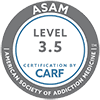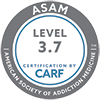Most individuals who struggle with alcohol and drug abuse have dietary problems as well.
At one end of the spectrum is an individual choosing fatty, sugary foods over more healthy options. At the other end, someone with substance issues may have extreme vitamin deficiency and malnutrition.
Often, regulating the body through proper nutrition is an important aspect of both in-treatment care and post-treatment recovery. Fresh, wholesome food is a catalyst to healing. One easy technique is to change the pH balance of your body from acidic to alkaline.
Why Nutrition Matters
Many treatment experts agree that improving whole body wellness begins with the detoxification process, and that includes changing diet. Cognitive dysfunction is apparent in a brain affected by chemicals. Studies point to how the right type of food helps recalibrate brain function and recovery after substance abuse.
The reintroduction of essential vitamins, minerals, antioxidants, and other vital compounds helps not only the brain recover, but also the body. The Substance Abuse and Mental Health Services Administration (SAMHSA) indicates that people suffering with addiction may have other elevated health risks, including obesity, diabetes, respiratory and infectious diseases, and cardiovascular complications.
SAMHSA has a variety of wellness initiatives that include proper nutrition and other techniques to help individuals and their families reduce the impact of addiction.
The Acidic Body
A pH level determines how alkaline or how acidic something might be. The lower the pH, the greater the acidic property; the higher the pH, the greater the alkaline property.
A neutral state of pH is 7. Throughout the body, pH properties are different. For example, your stomach is always more acidic, with a pH of 3.5 or less, to help it break down proteins and pathogens. But your blood is a little more alkaline, with a pH range of 7.35–7.45. Your urine’s pH level changes based on what you eat, and the fluid in your cells changes slightly as well. Your lungs and kidneys work hard to maintain equilibrium between acid and alkaline, because serious changes in the body’s overall pH level are life-threatening.
People with a consistently low pH often eat all the things on the “no” or “not often” list that make blood and urine more acidic:
- Fatty meats and other animal protein
- Dairy products
- Refined grains and simple carbohydrates such as white rice and bread
- Processed products, such as hot dogs, cold cuts, and frozen dinners
- Alcohol
- Artificial sweeteners
- Excessive caffeine
- Sugary treats, including soda
It’s not that these foods are completely bad. In fact, when paired with more alkaline options, such as a plate of dark, leafy greens, a steak and baked potato and a small pat of butter would be just fine.
But to frequently have a well-done steak with a build-up of carcinogens from the grill; combined with a baked potato smothered in cheese, bacon, and sour cream; and washed down with a beer might be too much acid for a body to process without serious effort.
Nutritionists refer to the body’s assessment of effort as “potential renal acid load,” or PRAL. Food isn’t always the main culprit, which is why the occasional fatty and sugary meal is fine for most of us.
But the compounded impact over time, combined with already leached minerals due to drug or alcohol misuse, creates a toxic environment. Higher PRAL forces primary systems to work even harder to maintain the proper pH balance. The body “steals” minerals from bones and muscles when systems start to fail at this process, creating the probability of chronic pain, kidney stones, high risk diseases, anxiety, depression, decreased bone density, and increased muscle wasting.
Creating an Alkaline Body
The good news is changing from an acidic eating plan to a more alkaline one is simple.
Start to maintain a more alkaline pH in your body through diet by:
- Improving your intake of vitamins and minerals through food choices and supplements
- Planning nutritious meals and snacks
- Reducing sugar and caffeine
- Keeping regular meal times—an important factor for maintaining blood sugar levels
- Drinking a lot of water
An alkaline diet is essentially what you already know about eating healthfully. You need to have five–to–eight servings of fruits and vegetables daily, especially leafy greens and low-sugar fruits such as berries, avocados, and citrus fruits.
Interestingly, even though lemons, limes, and tomatoes are all high-acid fruits, they actually help to make your body more alkaline. So even a cup of warm water with a squeeze of lemon first thing in the morning is an easy but effective way to manage your pH levels.
If you prefer animal protein sources over plant-based ones such as beans and tofu, make sure to choose lean cuts of meat and create plenty of variety. For example, red meat once a week, eggs three times a week, chicken or turkey breast three times a week, and fish high in omega-3 fatty acid two times a week.
Complex carbohydrates are great energy sources, but you need smaller portions to maintain blood sugar levels. So manage portions of brown rice and other whole grains well. Vegetables have carbohydrates, too.
Finally, remember sugar is its own kind of drug. Too often, people eat well while in a rehabilitation center, but once back into a regular routine outside the facility, they’ll turn to sugar to boost dopamine levels—even if they don’t realize they’re doing it for that reason. Use more natural sweeteners than granulated sugar whenever possible, and sparingly.
If you’re able to change your diet to include about 75 percent alkaline foods, you won’t need to test your pH. Your improved energy level, better sleep, and increased vitality will tell you it’s working!
New studies in nutritional psychiatry also indicate healthy dietary choices combined with effective treatment for substance abuse reduces the possibility that co-occurring disorders will affect your sobriety.
Other Sources:
Valley Recovery Center of California: 5 Foods Your Body Needs During Recovery.
Today’s Dietician: CPE Monthly: Substance Abuse and Nutrition.
Dr. Axe: 15 Acidic Foods to Avoid + Healthier Alternatives.
WebMD: Alkaline Diets.
LeafTV: How to Change Your Body Chemistry From Acid to Alkaline.




